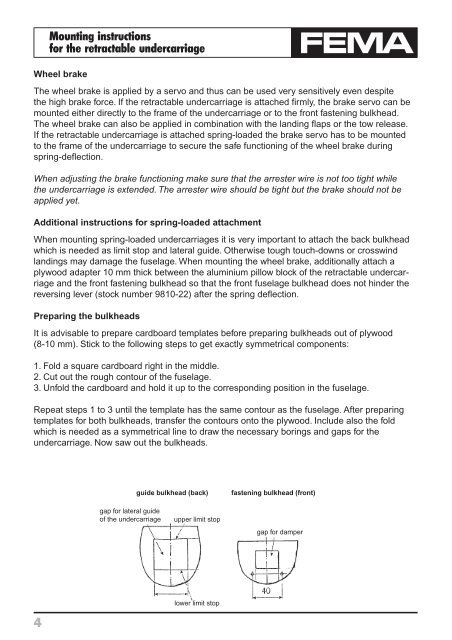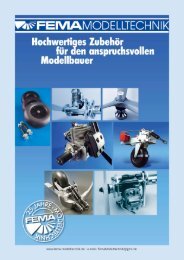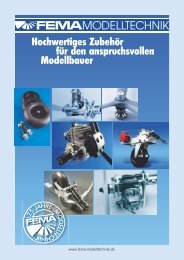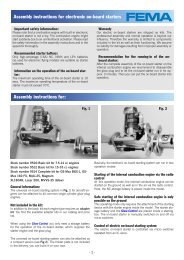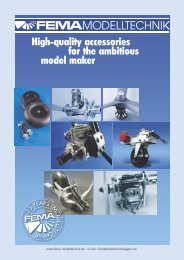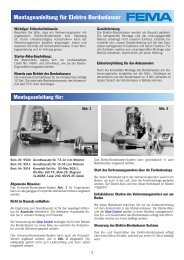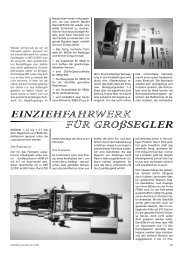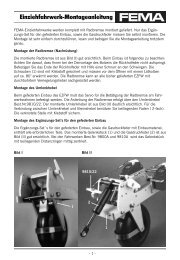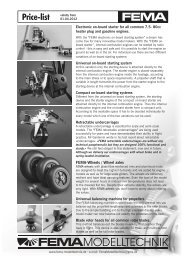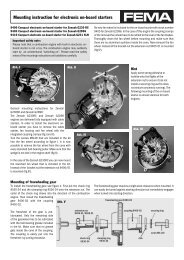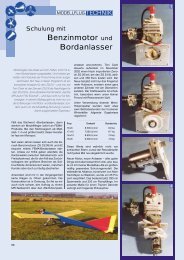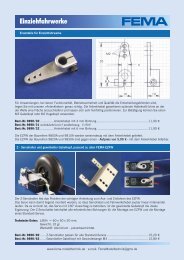Mounting instructions for the retractable undercarriage - FEMA ...
Mounting instructions for the retractable undercarriage - FEMA ...
Mounting instructions for the retractable undercarriage - FEMA ...
You also want an ePaper? Increase the reach of your titles
YUMPU automatically turns print PDFs into web optimized ePapers that Google loves.
4<br />
<strong>Mounting</strong> <strong>instructions</strong><br />
<strong>for</strong> <strong>the</strong> <strong>retractable</strong> <strong>undercarriage</strong><br />
Wheel brake<br />
The wheel brake is applied by a servo and thus can be used very sensitively even despite<br />
<strong>the</strong> high brake <strong>for</strong>ce. If <strong>the</strong> <strong>retractable</strong> <strong>undercarriage</strong> is attached firmly, <strong>the</strong> brake servo can be<br />
mounted ei<strong>the</strong>r directly to <strong>the</strong> frame of <strong>the</strong> <strong>undercarriage</strong> or to <strong>the</strong> front fastening bulkhead.<br />
The wheel brake can also be applied in combination with <strong>the</strong> landing flaps or <strong>the</strong> tow release.<br />
If <strong>the</strong> <strong>retractable</strong> <strong>undercarriage</strong> is attached spring-loaded <strong>the</strong> brake servo has to be mounted<br />
to <strong>the</strong> frame of <strong>the</strong> <strong>undercarriage</strong> to secure <strong>the</strong> safe functioning of <strong>the</strong> wheel brake during<br />
spring-deflection.<br />
When adjusting <strong>the</strong> brake functioning make sure that <strong>the</strong> arrester wire is not too tight while<br />
<strong>the</strong> <strong>undercarriage</strong> is extended. The arrester wire should be tight but <strong>the</strong> brake should not be<br />
applied yet.<br />
Additional <strong>instructions</strong> <strong>for</strong> spring-loaded attachment<br />
When mounting spring-loaded <strong>undercarriage</strong>s it is very important to attach <strong>the</strong> back bulkhead<br />
which is needed as limit stop and lateral guide. O<strong>the</strong>rwise tough touch-downs or crosswind<br />
landings may damage <strong>the</strong> fuselage. When mounting <strong>the</strong> wheel brake, additionally attach a<br />
plywood adapter 10 mm thick between <strong>the</strong> aluminium pillow block of <strong>the</strong> <strong>retractable</strong> <strong>undercarriage</strong><br />
and <strong>the</strong> front fastening bulkhead so that <strong>the</strong> front fuselage bulkhead does not hinder <strong>the</strong><br />
reversing lever (stock number 9810-22) after <strong>the</strong> spring deflection.<br />
Preparing <strong>the</strong> bulkheads<br />
It is advisable to prepare cardboard templates be<strong>for</strong>e preparing bulkheads out of plywood<br />
(8-10 mm). Stick to <strong>the</strong> following steps to get exactly symmetrical components:<br />
1. Fold a square cardboard right in <strong>the</strong> middle.<br />
2. Cut out <strong>the</strong> rough contour of <strong>the</strong> fuselage.<br />
3. Unfold <strong>the</strong> cardboard and hold it up to <strong>the</strong> corresponding position in <strong>the</strong> fuselage.<br />
Repeat steps 1 to 3 until <strong>the</strong> template has <strong>the</strong> same contour as <strong>the</strong> fuselage. After preparing<br />
templates <strong>for</strong> both bulkheads, transfer <strong>the</strong> contours onto <strong>the</strong> plywood. Include also <strong>the</strong> fold<br />
which is needed as a symmetrical line to draw <strong>the</strong> necessary borings and gaps <strong>for</strong> <strong>the</strong><br />
<strong>undercarriage</strong>. Now saw out <strong>the</strong> bulkheads.<br />
guide bulkhead (back) fastening bulkhead (front)<br />
gap <strong>for</strong> lateral guide<br />
of <strong>the</strong> <strong>undercarriage</strong> upper limit stop<br />
lower limit stop<br />
gap <strong>for</strong> damper


